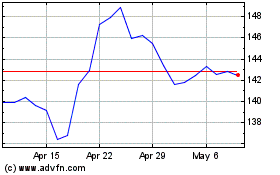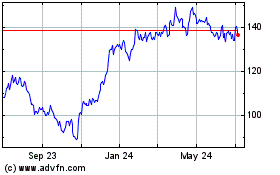By AnnaMaria Andriotis and Robin Sidel
U.S. credit-card balances are on track to hit $1 trillion this
year, as banks aggressively push their plastic and consumers grow
more comfortable carrying debt.
That sum would come close to the all-time peak of $1.02 trillion
set in July 2008, just before the financial crisis intensified, and
could signal an easing of frugal habits ingrained by the
recession.
The boom has been driven by steady economic conditions and an
improving job market that have made creditworthy consumers less
reluctant to take on debt. In addition, lenders have signed up
millions of subprime consumers who previously weren't able to get
credit.
Consumers are taking on other forms of debt, too. Auto-loan
balances surpassed $1 trillion in the first quarter, a record for
the industry, according to a report Thursday from credit bureau
Experian.
Credit cards are one of the few business lines working for banks
right now. Low interest rates have hurt margins on ordinary
lending, and a combination of tougher regulation and volatile
markets has crimped profits in trading. But banks' card operations
are benefiting from low delinquency rates and could become even
more profitable if interest rates rise.
Card issuers are trying to capitalize on the good times by
raising customers' credit limits, giving out more cards and pumping
up perks.
"We'll continue to take this opportunity as far as it will take
us," Richard Fairbank, chief executive at Capital One Financial
Corp., said in a recent conference call with investors.
Capital One, the nation's fourth-largest credit-card issuer,
said credit-card sales jumped 14% in the first quarter from a year
earlier. The company's strategy to boost card usage by raising
spending limits and giving out more cards is also paying off:
Capital One customers spent 20% more on their cards during the
first three months of the year than they did a year ago.
At Citigroup Inc., average credit-card balances in the first
quarter posted the first year-over-year increase since 2008. Such
balances also grew at Discover Financial Services Inc. and J.P.
Morgan Chase & Co., the nation's largest lender.
Even American Express Co., which historically has focused on
customers who pay their bills off every month, is now concentrating
on lending money to consumers who keep a balance.
Outstanding balances reached nearly $952 billion in the first
quarter, up 6% from a year earlier, and the highest level since
August 2009, according to the Federal Reserve.
"You could see $1 trillion this year," said David Blitzer,
managing director and chairman of the S&P Dow Jones index
committee, which tracks consumer-loan performance.
Overall consumer-spending trends remain uneven. Retail sales
were stronger than expected in April, although there are signs that
consumers are cutting back on nonessential purchases.
Because many creditworthy consumers are still cautious about
spending, lenders are turning more aggressively to subprime
borrowers. Lenders issued some 10.6 million general-purpose credit
cards to subprime borrowers last year, up 25% from 2014 and the
highest level since 2007, according to Equifax.
Citigroup and Discover, which typically focus on prime
customers, have rolled out cards aimed at less creditworthy
borrowers that carry a lower risk for issuers if those customers
can't pay their bills. Known as "secured" cards, they require
subprime borrowers to make a deposit that equals their card's
spending limits.
Many issuers are now lending to borrowers with a broader range
of credit scores, said Wayne Best, chief economist at Visa Inc.
That includes "some of the areas that have not been as fully
explored or serviced before, such as near-prime and subprime."
Overall, lenders gave out more than 104 million general-purpose
and store credit cards in 2015, up 6.5% from a year earlier and up
47% from the bottom in 2010, according to Equifax.
The boom isn't without risks. A return to economic turbulence
could trigger more defaults, which now stand near historic lows.
Industry wide, default rates on general-purpose credit cards
increased each of the first four months this year. In March,
default rates registered the largest month-over-month increase
since March 2010, according to Mr. Blitzer.
Delinquency rates on credit cards and car loans are rising in
several states hit by the energy slump as a growing number of
unemployed workers battle to keep up with their bills.
So far, though, business is good. Credit-card returns on assets,
a measure of profitability, are expected to hit 4.25% to 4.50% this
year for big lenders, compared with 4% in 2015, according to R.K.
Hammer Inc., a credit-card consulting firm. Overall bank returns
are roughly 1%, according to industry estimates.
"Credit cards are the best business in banking," said Robert
Hammer, who runs the consulting firm
Card profits could rise further as the Federal Reserve raises
benchmark interest rates, as most credit cards have variable rates
that move in tandem with the Fed.
The binge marks a reversal for lenders, many of whom retreated
from the credit-card market during the recession as defaults
increased. Some lowered credit lines for existing customers in an
attempt to limit additional losses, and others pulled back on
soliciting new customers.
Now, as the national unemployment rate remains low and more
borrowers have the income to pay their debts, competition among
lenders for new card customers is heating up again.
The new plastic comes with richer perks. Just a few years ago,
new customers who received Chase's popular co-brand card with
United Airlines received 30,000 miles and other perks. The lender
now is offering 50,000 miles on its British Airways card, with a
chance to pump that up to 75,000 miles.
In another popular perk, creditworthy borrowers can now receive
cash-back bonuses of as much as 5% in certain categories, compared
with longtime standards of 1%.
Keith Little, a telecom analyst in Maumelle, Ark., says he and
his wife recently signed up for a Citi card that returns 2% of all
purchases in cash. The couple, who stopped using credit cards in
2005 after paying off $10,000 in balances, now favors the cash-back
card for most of their purchases, which total about $2,500 a month.
The couple hopes that the windfall will defray some of the costs on
their next trip.
"Anything [that] can, goes on the Citi card," Mr. Little
said.
(END) Dow Jones Newswires
May 20, 2016 05:44 ET (09:44 GMT)
Copyright (c) 2016 Dow Jones & Company, Inc.
Capital One Financial (NYSE:COF)
Historical Stock Chart
From Mar 2024 to Apr 2024

Capital One Financial (NYSE:COF)
Historical Stock Chart
From Apr 2023 to Apr 2024
